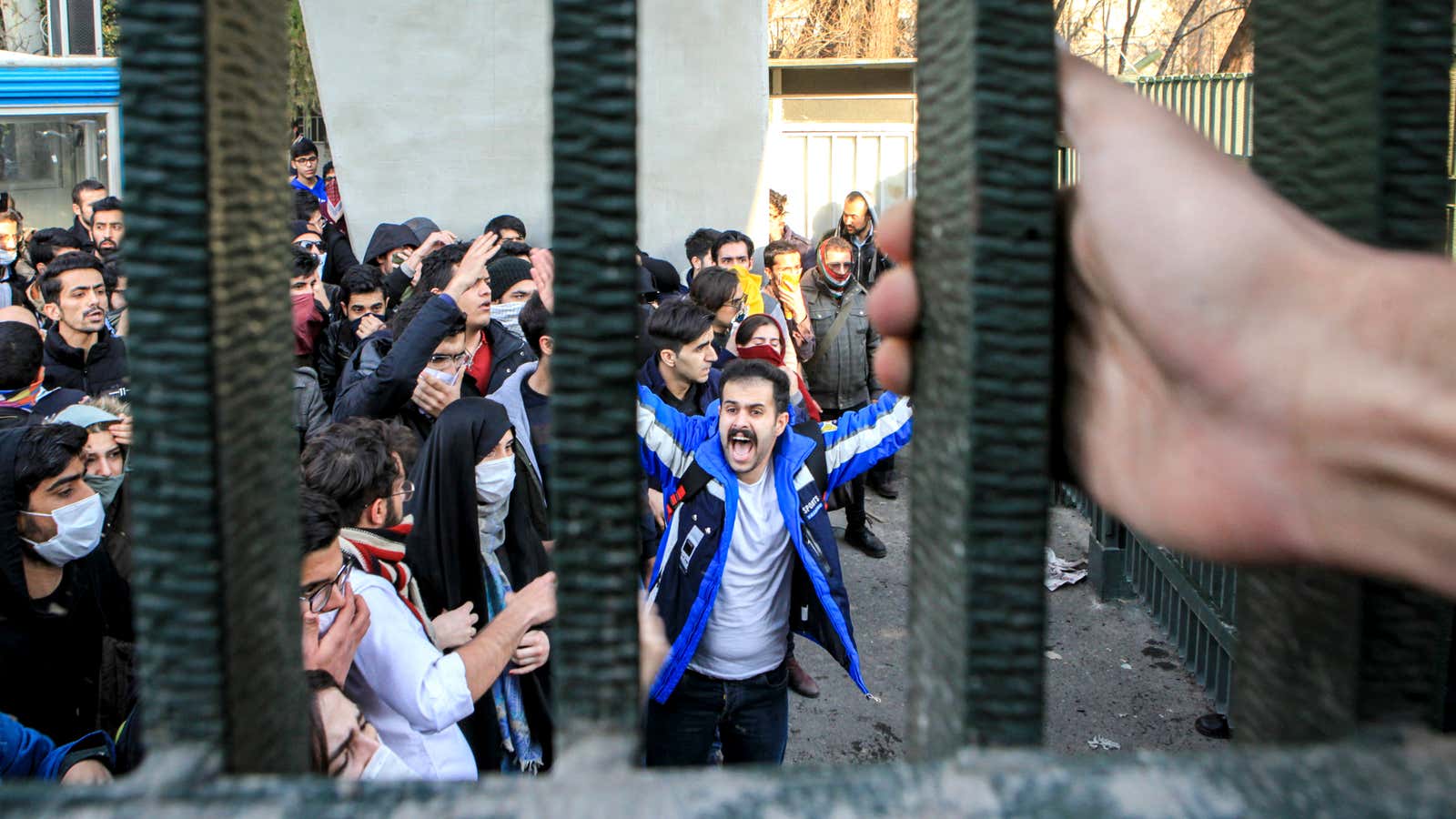President Donald Trump used a recent wave of anti-government demonstrations in Iran to criticize a 2015 deal the US and other global powers made with the country’s theocratic regime, which lifted wide-ranging economic sanctions in exchange for Iran putting an end to its plan to develop nuclear weapons.
“The people of Iran are finally acting against the brutal and corrupt Iranian regime,” Trump tweeted today. “All of the money that President Obama so foolishly gave them went into terrorism and into their ‘pockets.’ The people have little food, big inflation and no human rights.”
When the US ratified the deal in 2015, the possibility that the Iranian regime would receive access to $100 billion or more in seized assets and future revenue was a major point of contention. Critics of the deal said the country’s hardline supreme leader Ali Khamenei would funnel the cash into terrorism and proxy wars throughout the Middle East. Its proponents thought that president Hassan Rouhani would respond to popular desire for investment at home after years of Iranian leadership blaming foreign powers for the troubled economy.
“Partly because of our sanctions, the Iranian government has over half a trillion dollars in urgent requirements—from funding pensions and salaries, to paying for crumbling infrastructure,” Obama said of the deal in 2015. “And that’s why our best analysts expect the bulk of this revenue to go into spending that improves the economy and benefits the lives of the Iranian people.”
Yet the deal brought only modest improvements, with many Iranians expressing disappointment in both the US and their own government. Part of the problem has been low oil prices, which hurt the country’s most lucrative export, and low foreign investment thanks to economic sanctions that remained in place even after the nuclear program deal. The corruption that Trump referenced is also a real issue, with major economic power vested in the Iranian Revolutionary Guard Corps and religious foundations. And while it’s unknown how much of the money Iran spent pushing its often anti-US foreign policy in Lebanon, Syria, Iraq and Yemen, but those activities have only grown since 2015.
“The nuclear deal generated huge economic expectations that quite frankly were never going to be met,” says Ilan Goldenberg, a former official at the US departments of defense and state who now leads the Middle East Security Program at the Center for New American Security. “Sanctions relief was not as broad as it was presented to the Iranian people. It’s very easy for capital to flee but it comes back very slowly.”
Even in 2015, many warned changing the sanctions policy wouldn’t bring overnight prosperity.
“Iran’s economy continues to suffer from immense challenges—including perennial budget deficits, rampant corruption, and one of the worst business environments in the world,” then-Secretary of the Treasury Jack Lew said (pdf). “Put simply, Iran is in a massive hole from which it will take years to climb out.”
The same year, Rouhani’s economic advisor, Masoud Nili, said that “the sanctions relief would provide us with capabilities but does not make a miracle…. If we do not manage the existing gap [between public expectations and reality], we may face a situation worse than when we were under sanctions.”
The hopes pinned to the end of the economic restrictions may have played a role in the new demonstrations, which analysts say are notable for beginning with typically conservative and working-class populations, not the urban middle-class that has taken the lead in past Iranian protests. Goldenberg says the end of sanctions ”exposed the reality that Iran’s economy is not managed very well.”
“Iran’s leaders have raised the expectations of their people that sanctions relief will improve their lives,” Obama said in 2015. “Even a repressive regime like Iran’s cannot completely ignore those expectations.”
The latest wave of public outcry in Iran—and its anti-regime tone—may stem from the way these expectations have refocused popular attention on their own government and away from foreign states. Ironically, the protests may lead Trump to attack the Iranian economy again. Goldenberg says that January deadlines to waive US sanctions against Iran for continued compliance with the nuclear agreement could be Trump’s opportunity to kill the deal.
“The whole thing increases the likelihood that the nuclear deal is going to fall apart,” Goldenberg says of Trump’s attention to the demonstrations. “If he starts re-applying sanctions, the nuclear deal is dead.”
